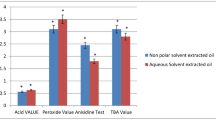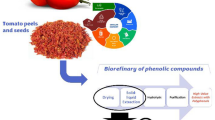Abstract
Tomato seeds represent a very large waste by-product from the processing of tomatoes into products such as tomato juice, sauce and paste. One potential use for these seeds is as a source of vegetable oil. This research investigated the oil content of tomato seeds using several extraction techniques as well as an examination of the oil extracts to determine the composition of the minor constituents such as phytosterol and antioxidant composition. The oxygen radical absorbance capacity (ORAC) of the tomato seed oils were also measured and correlated with antioxidant contents. This research demonstrated that tomato seed oil yield was highest using hot ethanol and followed by hot hexane and finally SC-CO2. The SC-CO2 treatment, however, had the highest total phytosterol content as well as highest individual phytosterol content. Sitosterol, cycloartanol, and stigmasterol were the most abundant phytosterols present in the extracts. The highest concentrations of antioxidants were found in the hexane extract. The most abundant antioxidants found in the tomato seed oils were all-trans-lycopene, cis-3-lycopene and β-carotene. ORAC was highest for the hexane extract. Oil yield was inversely proportional to both α-tocopherol and γ-tocopherol content and positively correlated with cis-3-lycopene content. ORAC values were positively correlated with only all-trans-lycopene and cis-3-lycopene demonstrating their role as antioxidants in the tomato seed oil.

Similar content being viewed by others
References
Knoblich M, Anderson B, Latshaw D (2005) Analyses of tomato peel and seed byproducts and their use as a source of carotenoids. J Sci Food Agric 85:1166–1170
Kaur D, Wani AA, Oberoi DPS, Sogi DS (2008) Effect of extraction conditions on lycopene extractions from tomato processing waste skin using response surface methodology. Food Chem 108:711–718
Ries SK, Stout BA (1962) Bulk handling studies with mechanically harvested tomatoes. Proc Am Soc Hortic Sci 81:479–483
Topal U, Sasaki M, Goto M, Hayakawa K (2006) Extraction of lycopene from tomato skin with supercritical carbon dioxide: effect of operating conditions and solubility analysis. J Agric Food Chem 54:5604–5610
Al-Wandawi H, Abdul-Rahman M, Al-Shaikhly K (1985) Tomato processing wastes as essential raw materials source. J Agric Food Chem 33:804–807
Sabio E, Lozano M, Montero de Espinosa M, Mendes RL, Pereira AP, Palavra AF, Coelho JA (2003) Lycopene and β-carotene extraction from tomato processing waste using supercritical CO2. Ind Eng Chem Res 42:6641–6646
Rabak F (1917) The utilization of waste tomato seeds and skins. US Dept Agric Bull 632:15
Firestone D (1999) Physical and chemical characteristics of oils, fats, and waxes. AOCS Press, Champaign
Vigo MS, Dasso I, Cattaneo P (1977) Studies on the seeds remaining after the processing of tomatoes. Seed oils, seed meals, and protein “isolate”. Fisicas y Nat 29:193–203
Roy BC, Goto M, Hirose T (1996) Temperature and pressure effects on supercritical CO2 extraction of tomato seed oil. Inter J Food Sci Technol 31:137–141
Vági E, Simándi B, Vásárhelyiné KP, Daood H, Kéry Á, Doleschall F, Nagy B (2007) Supercritical carbon dioxide extraction of carotenoids, tocopherols and sitosterols from industrial tomato by-products. J Supercrit Fluids 40:218–226
Rozzi NL, Singh RA, Vierling RA, Watkins BA (2002) Supercritical fluid extraction of lycopene from tomato processing byproducts. J Agric Food Chem 50:2638–2643
Baysal T, Ersus S, Starmans DAJ (2000) Supercritical CO2 extraction of β-carotene and lycopene from tomato paste waste. J Agric Food Chem 48:5507–5511
Gomez-Prieto MS, Caja MM, Herraiz M, Santa-Maria G (2003) Supercritical fluid extraction of all-trans-lycopene from tomato. J Agric Food Chem 51:3–7
Nobre BP, Palvra AF, Pessoa FLP, Mendes RL (2009) Supercritical CO2 extraction of trans-lycopene from Portuguese tomato industrial waste. Food Chem 116:680–685
Yi C, Shi J, Xue SJ, Jiang Y, Li D (2009) Effect of supercritical fluid extraction parameters on lycopene yield and antioxidant activity. Food Chem 113:1088–1094
Krinsky NI (1989) Antioxidant functions of carotenoids. Free Radic Biol Med 7:617–635
Burton GW, Ingold KU (1984) β-Carotene: an unusual type of lipid antioxidant. Science 224:569–573
Foote CS, Danny RW (1968) Chemistry of singlet oxygen. VIII. Quenching by β-carotene. J Am Chem Soc 90:6233–6235
Friedrich JP, List GR, Spencer F (1988) Semicontinuous supercritical CO2 system for rapid extraction of jojoba and other oilseeds. In: Baldwin AR (ed) Proceedings 7th Inter. Conf. on Jojoba and its uses. American Oil Chemists’ Society, Champaign
Sass-Kiss A, Kiss J, Milotay P, Kerek MM, Toth-Markus M (2005) Differences in anthocyanin and carotenoid content of fruits and vegetables. Food Res Int 38:1023–1029
Clinton SK, Emenhiser C, Schwartz SJ, Bostwick DG, Williams AW, Moore BJ, Erdman JW (1996) cis–trans Lycopene isomers, carotenoids, and retinol in the human prostate. Cancer Epidemiol Biomarkers Prev 5:823–833
Ishida BK, Ma J, Chan B (2001) A simple, rapid method for HPLC analysis of lycopene isomers. Phytochem Anal 12:194–198
Wu X, Beecher GR, Holden JM, Haytowitz DB, Gebhardt SE, Prior RL (2004) Lipophilic and hydrophilic antioxidant capacities of common foods in the United States. J Agric Food Chem 52:4026–4037
Prior RL, Hoang H, Gu L, Wu X, Bacchiocca M, Howard L, Hampsch-Woodill M, Haung D, Ou B, Jacob R (2003) Assays for hydrophilic and lipophilic antioxidant capacity (oxygen radical absorbance capacity (ORACFL)) of plasma and other biological and food samples. J Agric Food Chem 51:3273–3279
Haung D, Ou B, Hampsch-Woodill M, Flanagan JA, Deemer EK (2002) Development and validation of oxygen radical absorbance capacity assay for lipophilic antioxidants using randomly methylated β-cyclodextrin as the solubility enhancer. J Agric Food Chem 50:1815–1827
Itoh T, Tamura T, Matsumoto T (1977) 4-Desmethylsterols in the seeds of solanaceae. Steroids 30(3):425–433
Itoh T, Tamura T, Matusumoto T (1977) Triterpene alcohols in the seeds of solanaceae. Phytochemistry 16:1723–1726
Itoh T, Ishii T, Tamura T, Matsumoto T (1978) Four new and other 4α-methylsterols in the seeds of solanaceae. Phytochemistry 17:971–977
Gunstone FD, Harwood JL, Padley FB (1986) Major vegetable oils. In: Gunstone FD, Harwood JL, Padley FB (eds) The lipid handbook, 1st edn. Chapman & Hall, New York, pp 55–112
Lazos ES, Tsaknis J, Lalas S (1998) Characteristics and composition of tomato seed oil. Grasas y Aceites 49:440–445
Kiosseoglou B, Boskou D (1989) The composition of free and esterified sterols in tomato seed oil. Oleagineux 44:113–115
Farines M, Cocallemen S, Soulier J (1988) Triterpene alcohols, 4-methylsterols, and 4-desmethylsterols of eggplant seed oil: a new phytosterol. Lipids 23:349–354
Malecka M (2002) Antioxidant properties of the unsaponifiable matter isolated from tomato seeds, oat grains, and wheat germ oil. Food Chem 79:327–330
Kornfeldt A, Croon L-B (1981) 4-dimethyl-, 4-monomethyl-, and 4, 4-dimethylsterols in some vegetable oils. Lipids 16(5):306–314
Vasapollo G, Longo L, Rescio L, Ciurlia L (2004) Innovative supercritical CO2 extraction of lycopene from tomato in the presence of vegetable oil as a co-solvent. J Supercrit Fluids 29:87–96
Ciurlia L, Bleve M, Rescio L (2009) Supercritical carbon dioxide co-extraction of tomatoes (Lycopersicum esculentum L.) and hazelnuts (Corylus avellana L.): a new procedure in obtaining a source of natural lycopene. J Supercrit Fluids 49:338–344
Di Mascio P, Kaiser S, Sies H (1989) Lycopene as the most efficient biological carotenoids singlet oxygen quencher. Arch Biochem Biophys 274:532–538
Guil-Guerrero L, Rebolloso-Fuentes MM (2009) Nutrient composition and antioxidant activity of eight tomato (Lycopersicon esculentum) varieties. J Food Comp Anal 22:123–129
Acknowledgments
The authors wish to thank Jeffrey Teel, Jeanette Little and Kathy Rennick for their technical assistance.
Author information
Authors and Affiliations
Corresponding author
Additional information
Names are necessary to report factually on available data; however, the USDA neither guarantees nor warrants the standard of the product, and the use of the name USDA implies no approval of the product to the exclusion of others that may also be suitable.
About this article
Cite this article
Eller, F.J., Moser, J.K., Kenar, J.A. et al. Extraction and Analysis of Tomato Seed Oil. J Am Oil Chem Soc 87, 755–762 (2010). https://doi.org/10.1007/s11746-010-1563-4
Received:
Revised:
Accepted:
Published:
Issue Date:
DOI: https://doi.org/10.1007/s11746-010-1563-4




